Tensorflow CIFAR-10图像识别
【摘要】 使用Tensorflow ,完成CIFAR-10图像识别
使用Tensorflow ,完成CIFAR-10图像识别,作者:北山啦
数据集官网:The CIFAR-10 dataset

@[toc]
import warnings
warnings.filterwarnings('ignore')
import tensorflow as tf
import matplotlib.pyplot as plt
import os
import numpy as np
%matplotlib inline
-
CIFAR-10是一个更接近普适物体的彩色图像数据集。CIFAR-10 是由Hinton 的学生Alex Krizhevsky 和Ilya Sutskever 整理的一个用于识别普适物体的小型数据集。一共包含10 个类别的RGB 彩色图片:飞机( airplane )、汽车( automobile )、鸟类( bird )、猫( cat )、鹿( deer )、狗( dog )、蛙类( frog )、马( horse )、船( ship )和卡车( truck )。
-
每个图片的尺寸为32 × 32 ,每个类别有6000个图像,数据集中一共有50000 张训练图片和10000 张测试图片。
数据集介绍
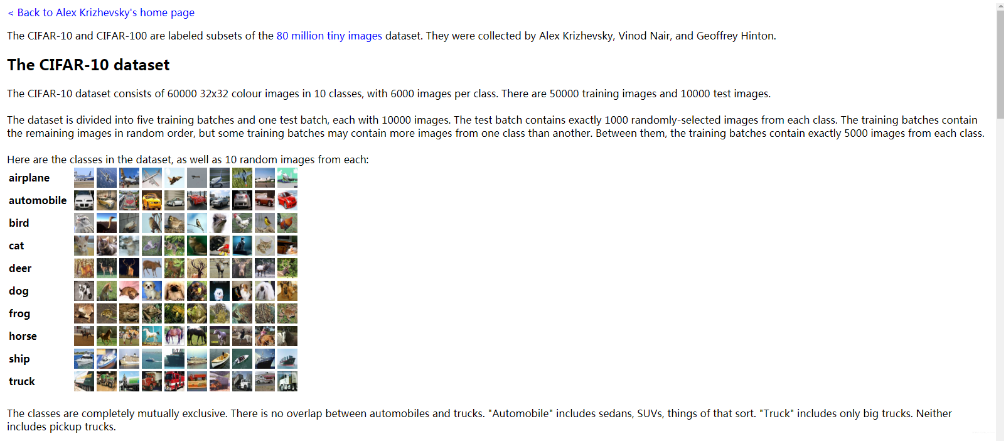
- CIFAR-10是一个用于识别普适物 体的小型数据集,它包含了10个类 别的RGB彩色图片。
- 图片尺寸: 32 x 32
- 训练图片50000张,测试图片 10000张

导入CIFAR数据集
def load_CIFAR_batch(filename):
with open(filename,"rb") as f:
data_dict = np.load(f,encoding="bytes", allow_pickle=True)
images = data_dict[b"data"]
labels = data_dict[b"labels"]
images = images.reshape(10000,3,32,32)
images = images.transpose(0,2,3,1)
labels = np.array(labels)
return images,labels
def load_CIFAR_data(data_dir):
images_train=[]
labels_train=[]
for i in range(5):
f = os.path.join(data_dir,"data_batch_%d"%(i+1))
print("正在加载",f)
image_batch,label_batch = load_CIFAR_batch(f)
images_train.append(image_batch)
labels_train.append(label_batch)
Xtrain = np.concatenate(images_train)
Ytrain = np.concatenate(labels_train)
del image_batch,label_batch
Xtest,Ytest = load_CIFAR_batch(os.path.join(data_dir,"test_batch"))
print("导入完成")
return Xtrain,Ytrain,Xtest,Ytest
data_dir = r"data\cifar-10-batches-py"
Xtrain,Ytrain,Xtest,Ytest = load_CIFAR_data(data_dir)
正在加载 data\cifar-10-batches-py\data_batch_1
正在加载 data\cifar-10-batches-py\data_batch_2
正在加载 data\cifar-10-batches-py\data_batch_3
正在加载 data\cifar-10-batches-py\data_batch_4
正在加载 data\cifar-10-batches-py\data_batch_5
导入完成
显示数据集信息
print("training data shpae:\t",Xtrain.shape)
print("training labels shpae:\t",Ytrain.shape)
print("test data shpae:\t",Xtest.shape)
print("test labels shpae:\t",Ytest.shape)
training data shpae: (50000, 32, 32, 3)
training labels shpae: (50000,)
test data shpae: (10000, 32, 32, 3)
test labels shpae: (10000,)
Ytest
array([3, 8, 8, ..., 5, 1, 7])
查看image和label
查看单项image
plt.imshow(Xtrain[6])
<matplotlib.image.AxesImage at 0xb7b5e48>
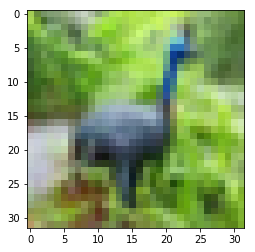
查看多项images
for i in range(0,10):
fig = plt.gcf()
fig.set_size_inches(12,6)
ax = plt.subplot(2,5,i+1)
# 去除坐标轴
plt.xticks([])
plt.yticks([])
# 去除黑框
ax.spines['top'].set_visible(False)
ax.spines['right'].set_visible(False)
ax.spines['bottom'].set_visible(False)
ax.spines['left'].set_visible(False)
# 设置各个子图间间距
plt.subplots_adjust(left=0.10, top=0.88, right=0.65, bottom=0.08, wspace=0.02, hspace=0.02)
ax.imshow(Xtrain[i],cmap="binary")

查看多项iamges和label
label_dict = {0:"airplane",1:"automobile",2:"bird",3:"cat",4:"deer",5:"dog",6:"frog",7:"horse",8:"ship",9:"trunk"}
def plot_images_labels_prediction(images,labels,prediction,idx,num=10):
fig = plt.gcf()
fig.set_size_inches(12,6)
if num >10:
num=10
for i in range(0,num):
ax = plt.subplot(2,5,i+1)
ax.imshow(images[idx],cmap="binary")
plt.xticks([])
plt.yticks([])
# 去除黑框
ax.spines['top'].set_visible(False)
ax.spines['right'].set_visible(False)
ax.spines['bottom'].set_visible(False)
ax.spines['left'].set_visible(False)
title = str(i)+","+label_dict[labels[idx]]
if len(prediction)>0:
title+="=>"+label_dict[prediction[idx]]
ax.set_title(title,fontsize=10)
idx += 1
# 去除坐标轴
plt.show()
plot_images_labels_prediction(Xtest,Ytest,[],1,10)
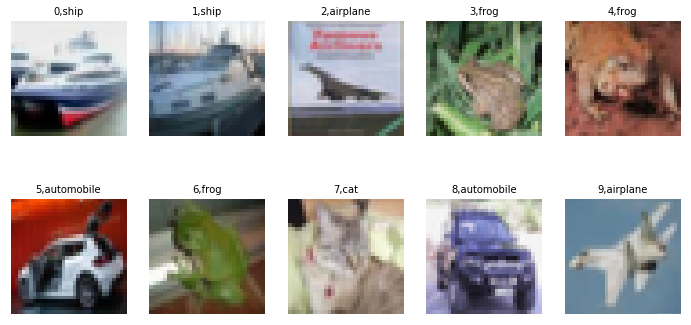
定义网络结构
- 图像的特征提取:通过卷基层1、降采样层1、卷积层2以及降采样层2的处理,提取网络结构
- 全连接神经网络:全连接层、输出层所组成的网络结构
图像的预处理
查看那图像数据信息
显示第一个图的第一个像素点
Xtrain[0][0][0]
array([59, 62, 63], dtype=uint8)
将图像进行数字的标准化
Xtrain_normalize = Xtrain.astype("float32")/255.0
Xtest_normalize = Xtest.astype("float32")/255.0
查看预处理后图像数据信息
Xtrain_normalize[0][0][0]
array([ 0.23137255, 0.24313726, 0.24705882], dtype=float32)
标签数据预处理–独热编码
- 能够处理非连续型数值特征
- 在一定程度上也扩充了特征
from sklearn.preprocessing import OneHotEncoder
encoder = OneHotEncoder(sparse=False)
yy = [[0],[1],[2],[3],[4],[5],[6],[7],[8],[9]]
encoder.fit(yy)
Ytrain_reshape = Ytrain.reshape(-1,1)
Ytrain_onehot = encoder.transform(Ytrain_reshape)
Ytest_reshape = Ytest.reshape(-1,1)
Ytest_onehot = encoder.transform(Ytest_reshape)
Ytrain[:10]
array([6, 9, 9, 4, 1, 1, 2, 7, 8, 3])
Ytrain_onehot.shape
(50000, 10)
Ytrain[:5]
array([6, 9, 9, 4, 1])
Ytrain_onehot[:5]
array([[ 0., 0., 0., 0., 0., 0., 1., 0., 0., 0.],
[ 0., 0., 0., 0., 0., 0., 0., 0., 0., 1.],
[ 0., 0., 0., 0., 0., 0., 0., 0., 0., 1.],
[ 0., 0., 0., 0., 1., 0., 0., 0., 0., 0.],
[ 0., 1., 0., 0., 0., 0., 0., 0., 0., 0.]])
定义共享函数
# 定义权值
def weight(shape):
# 在构建模型时,需要用tf.Variable来创建一个变量
# 再训练时,这个变量不断更新
# 使用函数tf.truncated_normal(截断的正太分布)生成标准差为0.1的随机数来初始化权值
return tf.Variable(tf.truncated_normal(shape,stddev=0.1),name="W")
# 定义偏置,初始值为0.1
def bias(shape):
return tf.Variable(tf.constant(0.1,shape=shape),name="b")
# 定义卷积操作,步长为1,padding为same
def conv2d(x,W):
return tf.nn.conv2d(x,W,strides=[1,1,1,1],padding="SAME")
# 定义池化操作
# 步长为2,即原尺寸的长和宽各除以2
def max_pool_2x2(x):
return tf.nn.max_pool(x,ksize=[1,2,2,1],strides=[1,2,2,1],padding="SAME")
定义网络结构

==图像的特征提取==:通过卷积层1,降采样层1,卷积层2以及降 采样层2的处理,提取图像的特征
==全连接神经网络==:全连接层、输出层所组成的网络结构
"""输入层,32*32图像,通道为3RGB"""
with tf.name_scope("input_layer"):
x = tf.placeholder("float",shape=[None,32,32,3],name="x")
"""第一个卷积层"""
with tf.name_scope("conv_1"):
W1 = weight([3,3,3,32])
b1 = bias([32])
conv_1 = conv2d(x,W1)+b1
conv_1 = tf.nn.relu(conv_1)
"""第一个池化层"""
with tf.name_scope("pool_1"):
pool_1 = max_pool_2x2(conv_1)
"""第一个卷积层"""
with tf.name_scope("conv_2"):
W2 = weight([3,3,32,64])
b2 = bias([64])
conv_2 = conv2d(pool_1,W2)+b2
conv_2 = tf.nn.relu(conv_2)
"""第二个池化层"""
with tf.name_scope("pool_2"):
pool_2 = max_pool_2x2(conv_2)
with tf.name_scope("fc"):
W3 = weight([4096,128])
b3 = bias([128])
flat = tf.reshape(pool_2,[-1,4096])
h = tf.nn.relu(tf.matmul(flat,W3)+b3)
h_dropout = tf.nn.dropout(h,keep_prob=0.8)
with tf.name_scope("output_layer"):
W4 = weight([128,10])
b4 = bias([10])
pred = tf.nn.softmax(tf.matmul(h_dropout,W4)+b4)
构建模型
with tf.name_scope("optimizer"):
y = tf.placeholder("float",shape=[None,10],name ="label")
loss_function = tf.reduce_mean(tf.nn.softmax_cross_entropy_with_logits(logits=pred,labels=y))
optimizer = tf.train.AdamOptimizer(learning_rate=0.0001).minimize(loss_function)
定义准确率
with tf.name_scope("evaluation"):
correct_prediction = tf.equal(tf.argmax(pred,1),tf.argmax(y,1))
accuracy = tf.reduce_mean(tf.cast(correct_prediction,"float"))
启动会话
import os
from time import time
train_epochs = 25
batch_size = 50
total_batch = int(len(Xtrain)/batch_size)
epoch_list=[]
accuracy_list = []
loss_list=[];
epoch = tf.Variable(0,name="epoch",trainable=False)
startTime = time()
sess =tf.Session()
init = tf.global_variables_initializer()
sess.run(init)
断点续训
ckpt_dir = "CIFAR10_log/"
if not os.path.exists(ckpt_dir):
os.makedirs(ckpt_dir)
saver = tf.train.Saver(max_to_keep=1)
ckpt = tf.train.latest_checkpoint(ckpt_dir)
if ckpt != None:
saver.restore(sess,ckpt)
else:
print("Training from search")
start = sess.run(epoch)
print("Training starts from {} epoch".format(start+1))
Training from search
Training starts from 1 epoch
迭代训练

def get_train_batch(number, batch_size):
return Xtrain_normalize[number*batch_size:(number+1)*batch_size],Ytrain_onehot[number*batch_size:(number+1)*batch_size]
for ep in range(start, train_epochs):
for i in range(total_batch):
batch_x,batch_y = get_train_batch(i,batch_size)
sess.run(optimizer, feed_dict= {x:batch_x, y:batch_y})
if i % 100 == 0:
print("Step {}".format(i), "finished")
loss,acc = sess.run([loss_function,accuracy],feed_dict={x: batch_x, y: batch_y})
epoch_list.append(ep+1)
loss_list.append(loss)
accuracy_list.append(acc)
print("Train epoch:", "%02d" % (sess.run(epoch)+1),"Loss=","{:.6f}".format(loss),"Accuracy=",acc)#保存检查点
saver.save(sess,ckpt_dir+"CIFAR10_cnn_model.cpkt",global_step=ep+1)
sess.run(epoch.assign(ep+1))
duration =time()-startTime
print("Train finished takes:",duration)
可视化损失
fig = plt.gcf()
fig.set_size_inches(4,2)
plt.plot(epoch_list,loss_list,label="loss")
plt.ylabel("loss")
plt.xlabel("epoch")
plt.legend(["loss"],loc="best")
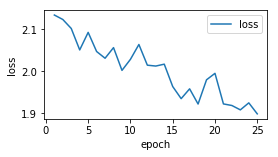
可视化准确率
plt.plot(epoch_list,accuracy_list,label="accuracy")
fig = plt.gcf()
fig.set_size_inches(4,2)
plt.ylim(0.1,1)
plt.ylabel("accuracy")
plt.xlabel("epoch")
plt.legend()
plt.show()
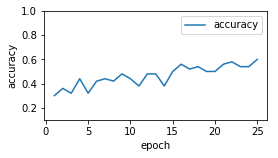
评估模型及预测
test_total_batch = int(len(Xtest_normalize)/batch_size)
test_acc_sum = 0.0
for i in range(test_total_batch):
test_image_batch = Xtest_normalize[i*batch_size(i+1)*batch_size]
test_label_batch = Ytest_onehot[i*batch_size:(i+1)*batch_size]
test_batch_acc = sess.run(accuracy,feed_dict={x:test_image_batch,y:test_label_batch})
test_acc_sum += test_batch_acc
test_acc = float(test_acc_sum/test_total_batch)
print("Test accuracy:{:.6f}".format(test_acc))
test_pred = sess.run(pred,feed_dict={x:Xtest_normalize[:10]})
prediction_result = sess.run(tf.argmax(test_pred,1))
plot_images_labels_prediction(Xtest,Ytest,prediction_result,0,10)
到这里就结束了,如果对你有帮助,欢迎点赞关注评论,你的点赞对我很重要,author:北山啦
【声明】本内容来自华为云开发者社区博主,不代表华为云及华为云开发者社区的观点和立场。转载时必须标注文章的来源(华为云社区)、文章链接、文章作者等基本信息,否则作者和本社区有权追究责任。如果您发现本社区中有涉嫌抄袭的内容,欢迎发送邮件进行举报,并提供相关证据,一经查实,本社区将立刻删除涉嫌侵权内容,举报邮箱:
cloudbbs@huaweicloud.com
- 点赞
- 收藏
- 关注作者



评论(0)